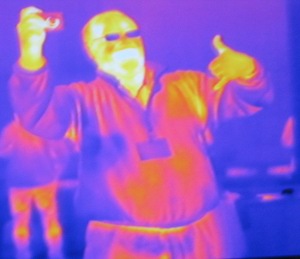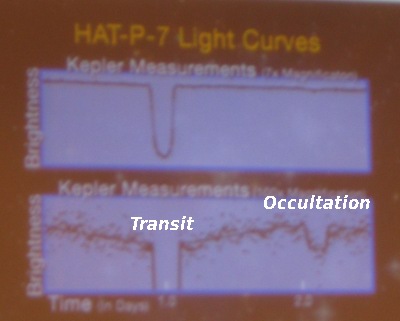On Technology and the Environment, Avatar, and Star Trek: Insurrection
![]()
Many have commented on the in-your-face social commentary of Avatar. Some have objected to the whole “white man’s burden” aspect, that the movie says the natives need a human to come in in order to save them. Others have pointed out the obvious contradiction of the movie’s blatant anti-technology message with the fact that this is a movie who’s very creation depending on cutting edge technology. I want to write about the latter here.
Specifically, I want to ask the question: is it even possible for a technologically advanced society to “remain in harmony with the environment”? I put that latter phrase in quotes, because it can mean a number of different things. I don’t want to fall into the whole wishy washy “mother Gaia”, we-must-not-disturb-any-blade-of-grass philosophy. Rather, I mean, is it possible for a technological society to exist without fouling its own nest? That is, without rendering the planet on which it emerges something that is less hospitable, or at the very least less pleasant to live on.
Avatar, admittedly with a sample size of one, says no. Humans are represented by technology. All of the colors of everything the humans do, with the exception of their explosions and their computer display screens, are grey. They’re represented by big buildings and big machines. They are industry and technology. In contrast, the Na’vi show a rainbow of colors in themselves, their dress, and the world they live in. They have low technology; they haven’t even picked up guns. (The only Na’vi we ever see shooting guns are avatars of humans.) They fully eschew technology and they live in complete harmony with their environment.
It’s an anti-progress message. Technology is bad, and without that you have the Noble Savage. Of course, this is a simplistic message, and it takes only the slightest of thought to realize that both messages cannot be completely true.

Which brings me to Star Trek: Insurrection. It wasn’t the greatest of Star Trek movies (although I’d rank it #2 out of the four Next Gen movies), but it did show something that we so rarely see in science fiction movies: a high-tech society that maintains its high tech, yet which evidently lives simply and in harmony with its environment.
The movie opens with a pastoral scene of an agrarian village living their happy, low-technology life. The camera pans back… into a hidden complex overlooking the village, with all kinds of people (in Star Fleet uniforms) watching them using high tech equipment. The room is dark, and the undertones of the music take on an ominous tone. We’ve all been through what Hollywood produced before, so we know how to react. Happy low-tech society comes into contact with nasty overbearing high technology; high technology, despite the Star Fleet uniforms, is evil. We know that only sadness can result from the interaction. (Well, except that this is Star Trek, so the happy good people have to win in the end.)
Things happen; Data (the android member of the crew) has something going wrong with him, and he ends up captured by the villagers. Picard and others costume themselves up in low tech clothes to go try to extract Data. Then the surprise comes. When they meet the villagers, one of them spews some technobabble, saying, “by the way, we fixed your android for you.”
What we’re seeing here is something we almost never see in Hollywood. It’s a high-tech society, that has not relinquished or forgotten about its technology, but that is living in harmony with its environment. Normally, Hollywood either glosses over it (as is the case usually in Star Trek), or technology is presented as something that inevitably leads to the destruction of the environment. It was really quite refreshing to see this, and to see the message that, hey, look, if you want to live the simple life, if you want to live in harmony with the environment, you don’t have to revert to the old days. You can maintain (say) medical technology that saves you from dying from a minor infection or saves you from permanent disfigurement from a broken bone. Too often, it’s presented as an either/or— if you don’t want to destroy your planet, you have to give up all of your technology. I reject that notion.
Coming back to Avatar, I have to admit that despite really liking the movie, I was a little disappointed in the “technology is evil” message. I honestly believe that it is at least in principle possible for a technologically advanced and advancing civilization to exist in such a way that it doesn’t ultimately render its planet ugly and less habitable. We haven’t fully done the experiment yet, but we’ve got one in progress. We have exactly one technologically advanced society to look at, and currently things aren’t looking so good. Based on the results of climate science, at best we can hope for expensive ongoing low-level environmental disasters in the next century as we adapt. I hope civilization manages to get through the next century or two, adapt to the problems we’ve created for ourselves, and eventually get things in balance again. But it’s entirely possible that things will be worse than that, that the pressures ultimately created by the climate change we ourselves have wrought are going to lead to very bad secondary social problems that severely mar civilization— and that’s not even considering the most dire predictions that come from climate scientists.
Climatology is hard enough that we don’t really know what will happen. But we know enough to know that there is an extremely strong probability that something will happen. Yet, the “debate”, at least in the USA, is caught up over whether or not we want to admit that the probability exists, over whether or not there were misdeeds on the part of some small fraction of the climate science community. We’re not really doing anything to mitigate the situation. I would have to say based on this sample size of one that the implicit contention of movies like Avatar— that technological civilizations ultimately foul their nest— appears to be correct. I’m not anti-technology, I’m decidedly pro-technology. But when I look at how we’re doing as a society as a whole, it’s hard to reject the movie as being baselessly “anti-technology”.
(Irrelevant afterward: another way to look at Avatar is that Pandora is in fact a high-technology society. It is the laboratory of a single, ancient, extremely vast and powerful being named Eywa, who has amazingly advanced biotechnology (including a biotechnological computer network). It’s bred the native species, and introduced DNA from somewhere else to create the Na’vi, combined with the DNA of the local species. Why are the Na’vi from somewhere else? Notice how all the animals of Pandora have six limbs. The land animals have six legs, the winged ones have four legs in addition to the two wings. But the Na’vi only have four limbs, and do not even have vestigial fifth and six limbs. This suggests that they have some ancestry that’s outside of the evolution of Pandora. Indeed, that outside DNA may well be from humans, collected by Eywa after she mutilated enough cattle to realize that they weren’t a good source. That explains why it was even possible for humans to create Na’vi avatars that they could transfer themselves into.)



